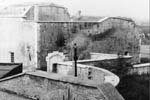|
As early as 1555, the war councillors
planned to build a palisade on the left bank
of the river Vaag, which would be connected
to the Old Fortress by a pontoon bridge.
However, the war council passed a resolution
only in 1577 to build a palisade which could
hold 100 horsemen. The work started in 1585.
In the first decades – and even in 1649 –
the building was called St Nicholas and
later St Philip palisade. It was demolished
in 1661, as it did not suit the requirements
of that period, and in its place a new and
stronger palisade was built. In the second
half of the 17th century the Jesuits built a
chapel in honour of their saint. In 1866,
when the biggest work was done, the central
part of the fortress was the star-shaped
fortress. The rest of the ramparts were
probably located according to the previous
plan of the palisade. The highest level of
the bastions (upper terrace) was
asymmetrical due to the cuttings in the
salients. (summits of the bastions). At the
highest point of the bastion,where two ramps
led, a gun-site was placed. The upper
terrace could also be approached on two
ramps. In the central fortress a
four-winged, rectangular shaped closed
building complex was built, which most
likely served as a barrack. From two sides
of the star-shaped central fortress - toward
northwest and southeast - a chain of
fortifications spread, with three bastions
in both directions. This chain of
fortifications spread from the bank of the
Vaag toward bastion II of the central
fortress, while on the other side of the
fortress it spread from bastion III toward
the mouth of the river Vaag. The plan of the
bastions was asymmetrical pentagon or
hexagon. On the ledges of the upper terrace
gun-positions were built. The bridge-head
could be approached on a pontoon bridge from
the central fortress. Unfortunately this
bridge-head can be only seen in ruins now.

|
The other ramparts were probably placed
according to the plan of the previous
palisade. The Danube bridge-head (Fort
Csillag) is situated on the right bank of
the river, opposite the eastern bastion of
the Old Fortress. It was built at the same
time as the Vaag bridge-head. In the second
half of the 17th century the Jesuits also
built a chapel here, commemorating St.
Peter. This fortress was also neglected
after the Turkish rule ended.
However, the bastions built from earth were
still there in 1810. The fortress played a
significant role during the fight for
freedom. Later, between 1850 and 1870, it
was rebuilt from stone and brick as one of
the most important elements of the new
defence system.
|